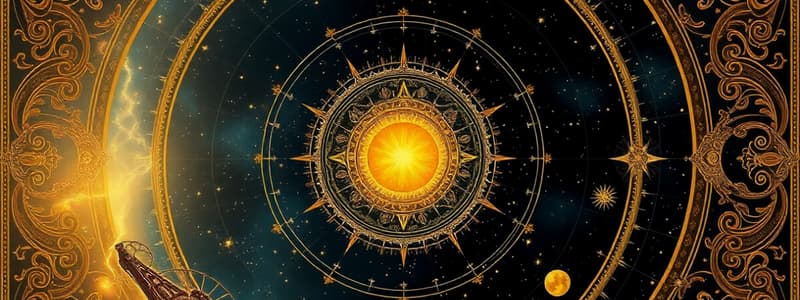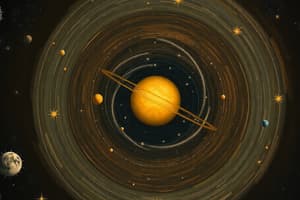Podcast
Questions and Answers
What phenomena on Earth are caused by the relative positions of the sun, Earth, and the moon?
What phenomena on Earth are caused by the relative positions of the sun, Earth, and the moon?
Seasons and eclipses
Who created the geocentric model of the Solar System?
Who created the geocentric model of the Solar System?
- Galileo
- Aristarchus
- Nicolaus Copernicus
- Ptolemy (correct)
What does the prefix 'geo-' refer to?
What does the prefix 'geo-' refer to?
Earth
What does the prefix 'helio-' refer to?
What does the prefix 'helio-' refer to?
The heliocentric model was first proposed by Copernicus.
The heliocentric model was first proposed by Copernicus.
What was one piece of evidence that allowed Copernicus' heliocentric theory to be accepted?
What was one piece of evidence that allowed Copernicus' heliocentric theory to be accepted?
What does retrograde mean?
What does retrograde mean?
What evidence supported the geocentric model?
What evidence supported the geocentric model?
Which of the following is not a component of the Solar System?
Which of the following is not a component of the Solar System?
List the eight planets in our Solar System in order from the Sun outwards.
List the eight planets in our Solar System in order from the Sun outwards.
A star system contains a home star, planets, asteroids, and ______.
A star system contains a home star, planets, asteroids, and ______.
Flashcards
Geocentric Model
Geocentric Model
Earth is the center of the Solar System, with other celestial bodies revolving around it.
Heliocentric Model
Heliocentric Model
The Sun is the center of the Solar System, with planets revolving around it.
Retrograde Motion
Retrograde Motion
The apparent backward movement of a planet in its orbit.
Stellar Parallax
Stellar Parallax
Signup and view all the flashcards
Evidence for Heliocentrism
Evidence for Heliocentrism
Signup and view all the flashcards
Solar System
Solar System
Signup and view all the flashcards
Planets in Solar System (Order)
Planets in Solar System (Order)
Signup and view all the flashcards
Natural Satellites
Natural Satellites
Signup and view all the flashcards
Copernicus
Copernicus
Signup and view all the flashcards
Ptolemy
Ptolemy
Signup and view all the flashcards
Study Notes
Introduction to the Solar System
- The solar system includes a star, planets, asteroids, and comets
- Earth's predictable phenomena, like seasons and eclipses, are due to the relative positions of the sun, Earth, and the moon
- The objective of the lesson is to understand the history of the solar model and the components of the solar system.
- Success criteria include contrasting geocentric and heliocentric models, and identifying solar system components.
History of the Solar System
- Initially, the geocentric model, where Earth was the center, was created by the Greeks and further developed by Ptolemy
- Ptolemy was an Egyptian astronomer
- Geo- refers to Earth, and -centric refers to the center
- Later, Aristarchus (3rd century) proposed the heliocentric model (Sun-centered), but it was refuted
- In 1543, Nicolaus Copernicus proposed the heliocentric model once again. Sufficient evidence supported his claim and it was accepted.
Evidence for Heliocentrism
- Key evidence supporting the heliocentric model, which allowed Copernicus' theory to be accepted, was that it involved fewer assumptions and explained the retrograde motion of planets.
- Retrograde motion means the apparent backward movement of planets
- Other evidence includes the shapes of Venus (light reflection and position), the moons of Jupiter (natural satellites), and the sunsets on Mars (angular size of the sun).
- The angular size of the sun shows that increased distance from the Sun decreases the observed size.
Heliocentric vs. Geocentric Model
-
Initially, evidence supporting the geocentric model included stellar parallax (movement of celestial bodies due to position).
-
However, distance alters stellar parallax, making the moon appear to follow you at night, because it's too far away to show an apparent shift.
-
The heliocentric model is correct because it also uses the concepts of shape of Venus, Moons of Jupiter, sunsets on Mars as proofs of the correctness.
Components of the Solar System
- Our solar system has 8 planets, 1 dwarf planet, an asteroid belt, and comets.
- The planets in order from the sun outward are:
- Mercury
- Venus
- Earth
- Mars
- Jupiter
- Saturn
- Uranus
- Neptune
- Pluto
Studying That Suits You
Use AI to generate personalized quizzes and flashcards to suit your learning preferences.
Related Documents
Description
This quiz explores the fundamental concepts of the solar system, including its components like planets, asteroids, and comets. It also covers historical models such as the geocentric and heliocentric theories. Understand the significance of celestial phenomena and the evolution of our knowledge about the solar system.



